“It was the Best of Times; it was the Worst of Times” — Charles Dickens
I was glad my flight back to Croatia from the US was cancelled, thanks to Covid, as I finally had a green light to get into a photography course in South Africa. Since I was a small child, I dreamed of visiting the Dark Continent to see the exotic animals like Mountain gorillas—literal dreams: While I slept, elephants would talk to me and lions carry me on their backs! It is therefore not surprising I now fantasized about using that extra week to add a true wildlife experience. I rolled up my sleeves, and began researching and networking. As all my friends had been to Africa, I was on my own, but I had some recommendations: Book a tour to the Serengeti, visit the famous Giraffe Manor in Kenya, ride an ultralight over Victoria Falls in Zambia, photograph the dramatic red deserts of Namibia. As a nature lover and wildlife enthusiast, I was open to any possibility.
It was March, 2021 and If I was leaving in a month, I had to hustle. I usually prefer to make my own arrangements, but solo travel on a new continent might not be the wisest choice this time. Which of Africa’s 54 countries should I visit? Few tour companies were offering safaris yet, but a friend recommended a private guide who specializes in exclusive luxury tours in East Africa. As I researched the animals and the countries, I began to get excited about gorilla trekking in Uganda. I was captivated by the videos of gorilla families playing in the bush, photos of majestic silverbacks, and reviews of how magical the experience was. And since there are only 800 wild Mountain gorillas left, I needed to see them while it was still possible.
The guide was prompt and professional and I concluded this was kismet. I was on my way to hack through the jungles for a glimpse of truly wild animals in their habitat! I look back and wonder, what was I thinking?
Never mind that I had to get malaria medication and fly from Maui to O’ahu for my Yellow Fever Shot. And it was good news that Uganda accepts Covid tests up to 96 hours old, as it would take me 4 days of flying; yes, 3 red-eye flights, crossing the US to Europe and on to the Dark Continent. Undaunted, I went for it.
Abiaz Rwamwiri met me at the airport at 2 am and after a much needed sleep we began driving from Entebbe to Bwindi National Park, a 2 day drive as congested, noisy cities gave way to ramshackle villages. Farm animals grazed on the roadsides, as people carried multiple stalks of green bananas on their heads—on foot or motorcycle. How did the graceful women, bedecked in rainbows of color, walk the dusty roads and keep buckets of water balanced on top?
After a relaxing evening at the Igongo Hotel in Mbarara, we traveled on.

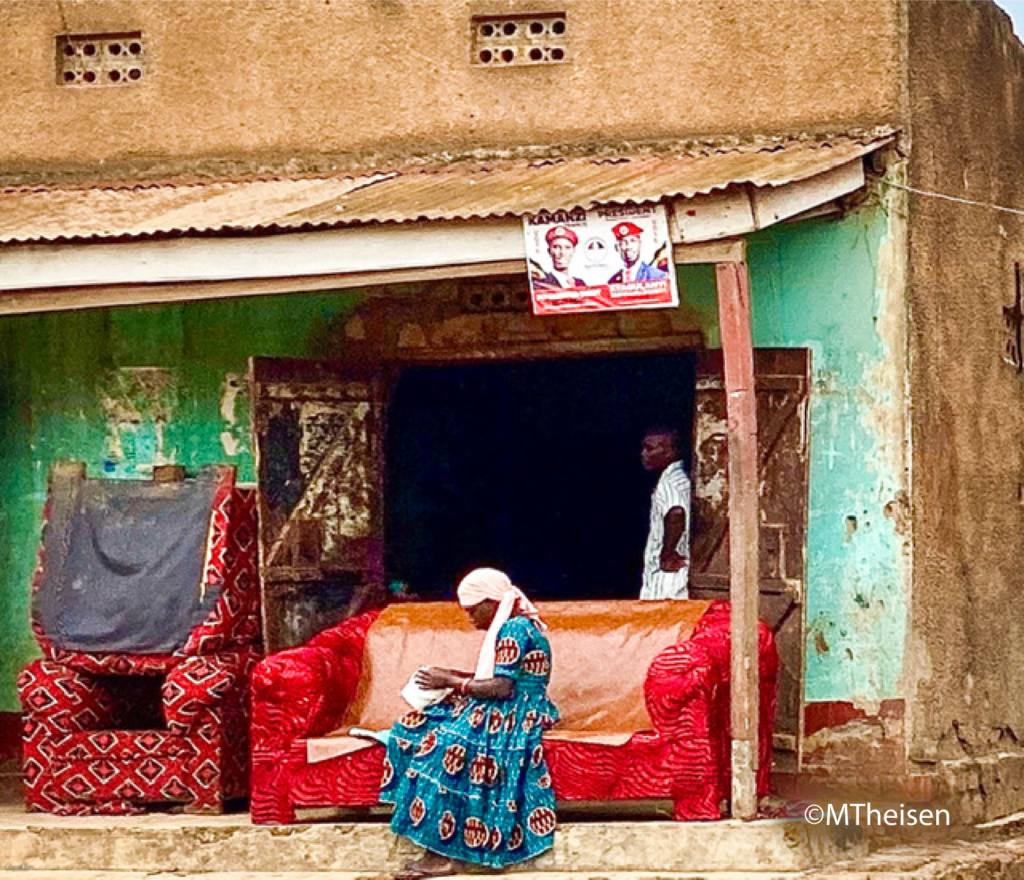

Rolling green hills, massive plains, and mysterious swamps gave rise to majestic mountains. We munched on fried plantains and stopped to photograph zebras, impalas, and longhorn cattle. My knowledgeable guide satisfied my curious mind with stories of Ugandan history and politics, and information about wildlife, people, languages and more. I got more and more excited about the Mountain gorillas, as he had studied the behavior of these particular animals for 10 years and knew of every nuance; in fact he had guided explorations for National Geographic!
We settled in at the luxurious Mahagony Springs Lodge on the edge of the Bwindi Impenetrable Forest, where comfort and quality service helped us unwind. Abiaz pointed at the mysterious nearby mountain and explained this is where the apes live. There are 21 families, each followed daily by trackers with radios. In the evening, when these primates make their nests for the night the trackers go home, arriving the next morning prepared to take trekkers up through the morning mist. Trekkers are divided into small groups, each assigned to a gorilla family and its trekkers. Once the family is located in the forest, visitors unpack their cameras and have one hour before they must leave them in privacy.
Somehow phrases like Mountain Gorillas and Impenetrable Forest didn’t really register, neither for me, nor the older American couple (the only other guests braving Covid travel from the US) staying in the Lodge until that evening. I explained to Abiaz that I have always had altitude sickness, even when younger and more fit. “No problem,” he assured me; they are prepared for trekkers at all fitness levels. And it didn’t matter about my sports injuries as we would hire porters to carry cameras, food, water and rain gear.
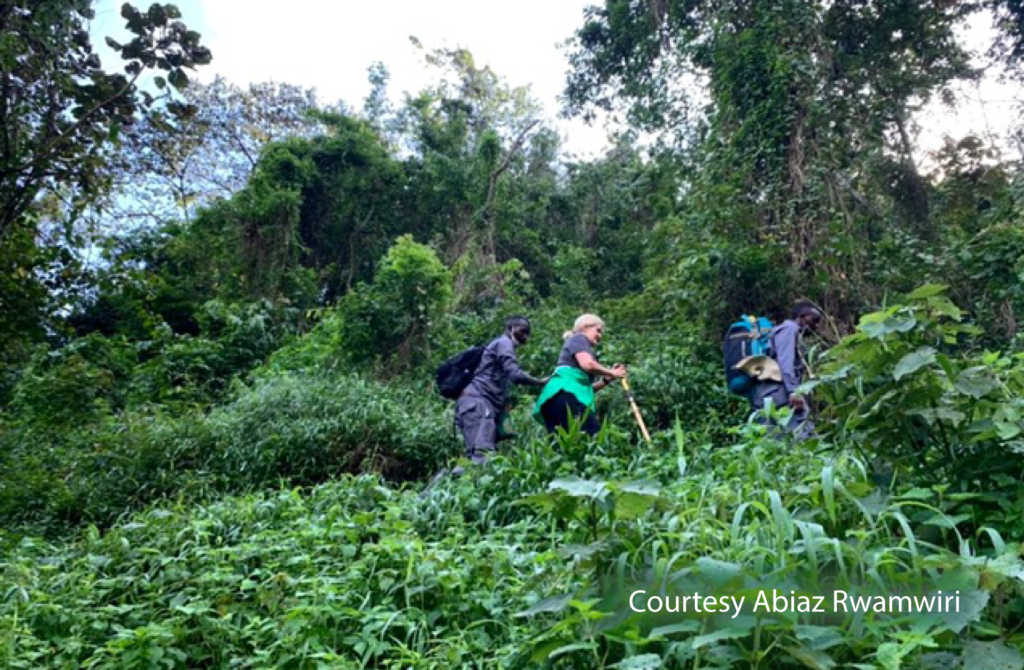
Abiaz knows the staff at Bwindi because of his previous research there; he arranged for a fun group of us to hike up to Rushegura, the largest family of 18 individuals. I didn’t realize this was at the very top of the mountain, 3 1/2 miles up. The further we went, the more rugged it got. I had one porter leading me by the hand, and (on high climbs) the other discreetly lifting my hips. “I don’t need help; I’m not fragile,” I protested, but quickly changed my opinion about that. As usual, I had to stop and catch my breath periodically, assuring the wary sherpas I was not going to die. But unusually, I started vomiting. Did you know malaria medication is best taken at bedtime with fatty food like ice cream? I didn’t. I knew the porters and guides had to bury bodily waste with their machetes, but I was sick enough to let it spew all over leaves—about nine times!
Once the trackers located the best access into the Impenetrable Forest, we left the trail and bounced along on several feet of cut foliage and branches, ducking under vines. On we went, now wearing masks to protect the primates from Covid, and finally found them! I took a break from puking to photograph a magnificent silverback, along with his women and children. One, a thin 3 month old baby with red hair, was suffering from malnutrition because her aging mother wasn’t producing enough milk for her. They were calm and peaceful, conserving energy by eating while lying down or seated. In order to maintain their weight, these powerful creatures must consume about 18 kilos (40 pounds) of food per day. Mothers were entertaining their breast-feeding babies so that the silverback, the size of a cow, could eat in peace. Occasionally one would climb a tree and when ready to descend, would slide down like a firefighter on a pole. I noticed the proud silverback was missing some fingers. I was told he had taken over this family by fighting the incumbent male and winning, but not without having his fingers chewed off. It seems these gentle giants are not so gentle when it comes to forming and defending their families.
When I did need to empty my stomach again, Abiaz was kind enough to snap a few photos with my camera. Even without physical issues, shooting pictures as animals moving from bright sunlight into shaded thickets proved to be quite challenging. The porters and guides cheered me on. A couple of young women ignored the instructions of the guides, even mocking them, as they moved closer. The silverback charged us. I knew not to run, but I froze and was chided by everyone because I missed the shot. (Stay tuned for the next installment when almost nothing would keep me from photographing a charging elephant in South Africa.)
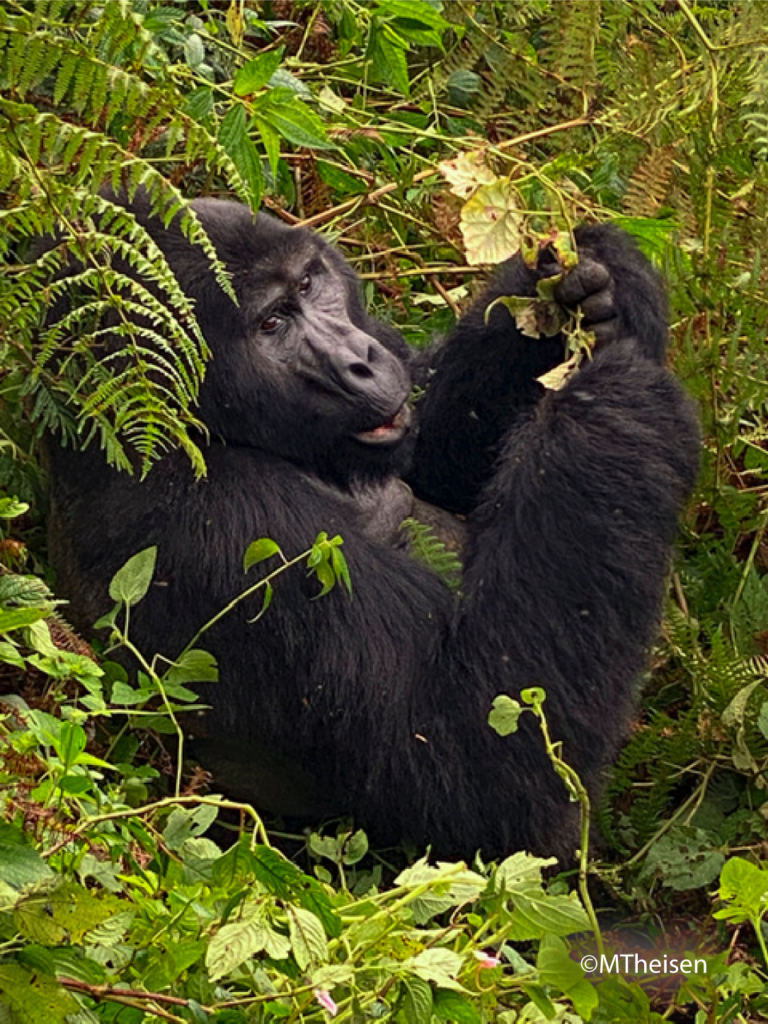
When our allotted hour was finished, we packed up to walk down the mountain. I assumed it would have to be much easier with gravity on my side, but then the heavens opened and torrents of monsoon rain drenched us. Abiaz wanted us to get off the mountain quickly and instructed me to put an arm around each porter as they assisted (dragged?) me down the muddy trails. As I descended, my toes pounded against my shoes, leaving me with bruised toes. My hiking shoes fell apart but were restitched by the next day.
I survived with only embarrassment as my consequence. I was mortified at slowing down my group. The American couple on another trek ended up having to be carried down in litters—big padded car seats with poles. 8 men run along, each dropping out and being replaced every 15 minutes by a team member; it takes 16 people to get one person down by what is euphemistically called a Ugandan Helicopter.

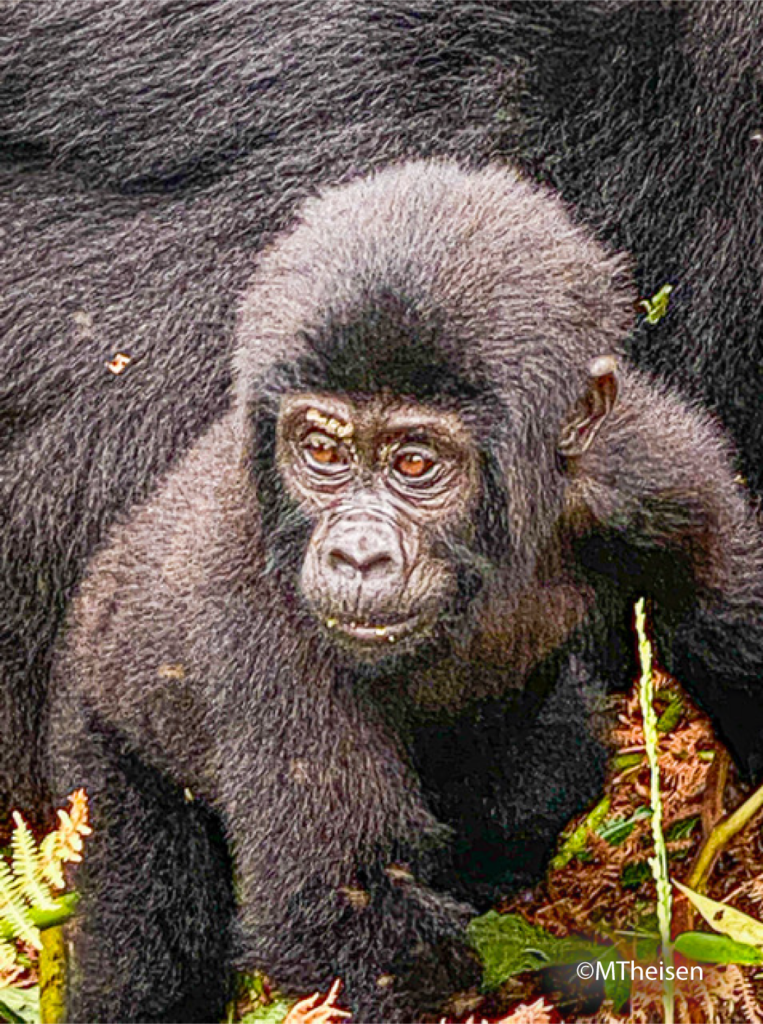
Ever a glutton for punishment, I trashed my malaria pills and signed on for Day 2. This gorilla group, Mubare, was much more accessible, a shorter distance but a steeper climb. This time the silverback peaked down from the treetops, making sure we were not threatening his family. There was no way to point a camera at the sky and snap a clear shot of his shaded face. Several mother-baby dyads foraged below him. One little guy had an eye infection and it occurred to me that of course, Mountain gorillas get physical challenges but there is no way to medically treat these wild animals. I found myself mimicking the trackers and grunting in gorilla-speak. I was reminded of Sigourney Weaver in “Mountain Gorillas in the Mist,” rumbling like Diane Fosse who died protecting creatures like these just across the border in Rwanda.
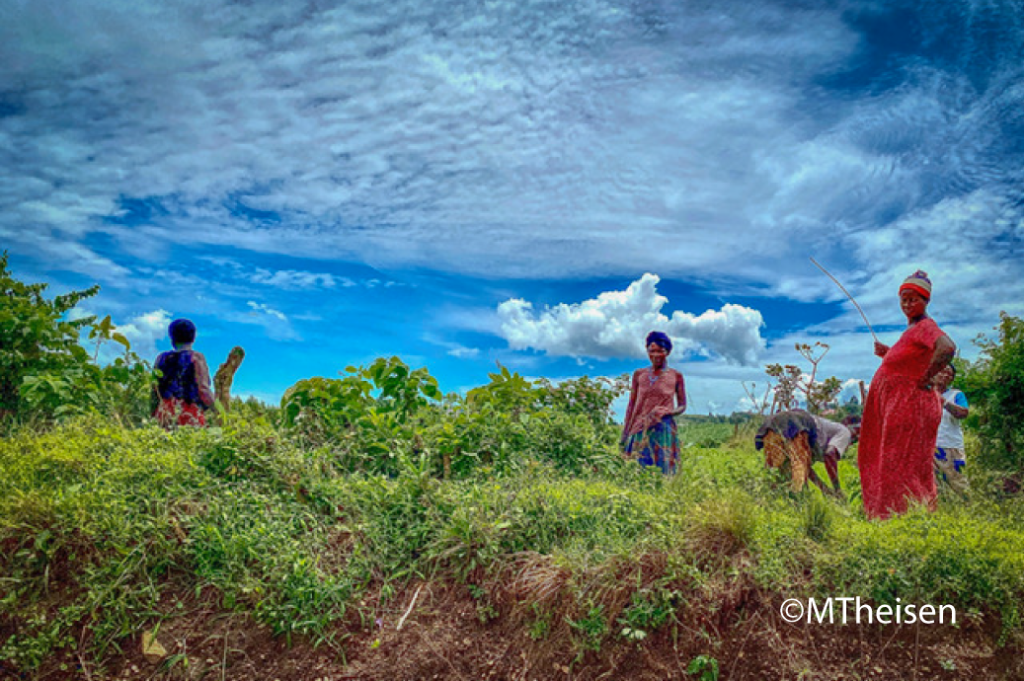
We managed to make it up and down before the rains came and had a nice rest before the two day drive back to Entebbe, another Covid test, and preparations for the flight to South Africa. I managed a Behind the Scenes tour at the Uganda Wildlife Education Center, feeding chimpanzees and giraffes, observing the big cats, petting a shoebill and rhino, and discovering more about many species.
I was so incredibly humbled by the experience, not only because of my mortifying hardships, but because of the dedication of the park staff who protect these primates and educate visitors. I learned volumes about gorilla behavior patterns and group dynamics, politics, poaching and more. And I was excited about understanding the complexities of many other species in my upcoming visit to Southern Africa.
Here are my Top 10 Tips for gorilla trekking in Uganda:
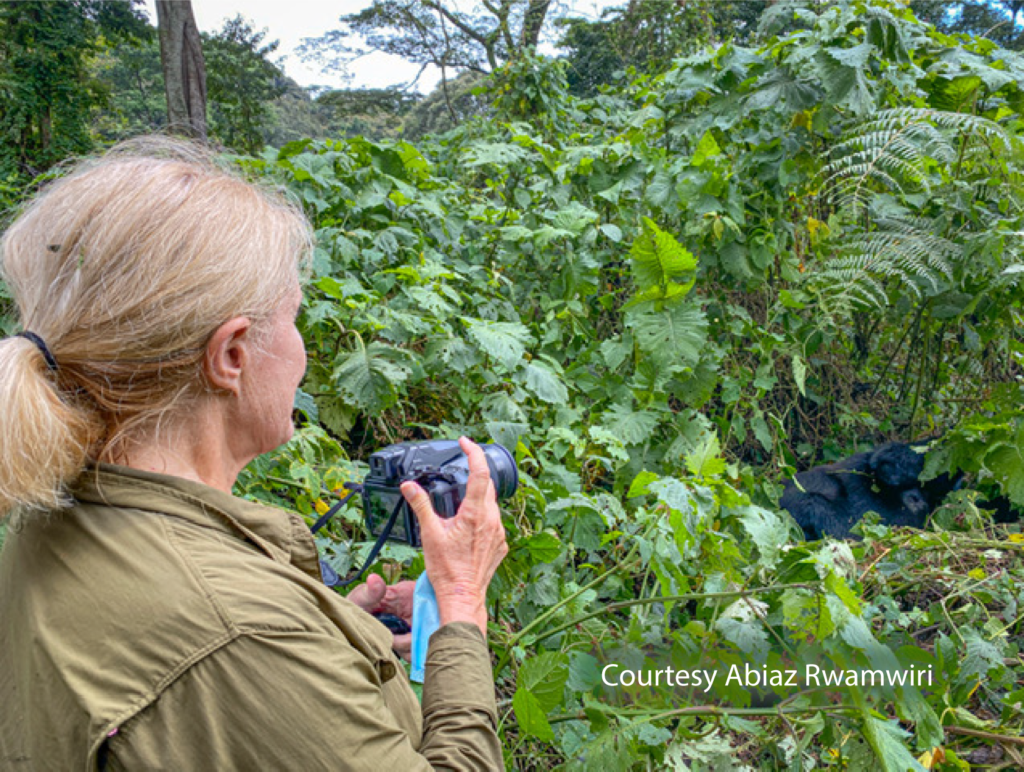
- Don’t drive yourself to the parks; the roads are rugged and the driving style is guaranteed to raise your blood pressure.
- Because the parks are far from civilization, do it first class this time. Hire a guide like Abiaz who will go above-and-beyond his job description to make sure you have a quality experience. Abiaz Rwamwiri, www.AfricaWildExpeditions.com, +256784567474. He customizes tours in several East African Countries. You don’t have to worry about how to get anywhere, what to eat, where to stay; he’s got it covered.
- Take malaria medication at night with ice cream or peanut butter.
- Bring layers of clothes, good hiking boots, and plenty of enthusiasm.
- Know your limits and communicate them in advance.
- Sample the Ugandan Waragi Gin, made from distilled fermented bananas.
- If you bring cash, bring new bills as the banks and exchanges will not accept old bills. Exchange your money at the airport, no matter how exhausted you are, because once you are in the countryside, an ATM can be nearly impossible to locate.
- Be prepared to wire funds to pay for your trip before you go. This is a normal practice in many African countries.
- Interact with the locals who are some of the friendliest and happiest people anywhere.
- Get to Bwindi a couple days early to acclimate to the elevation; you will be starting your climb at 6000 feet (1828 Meters).

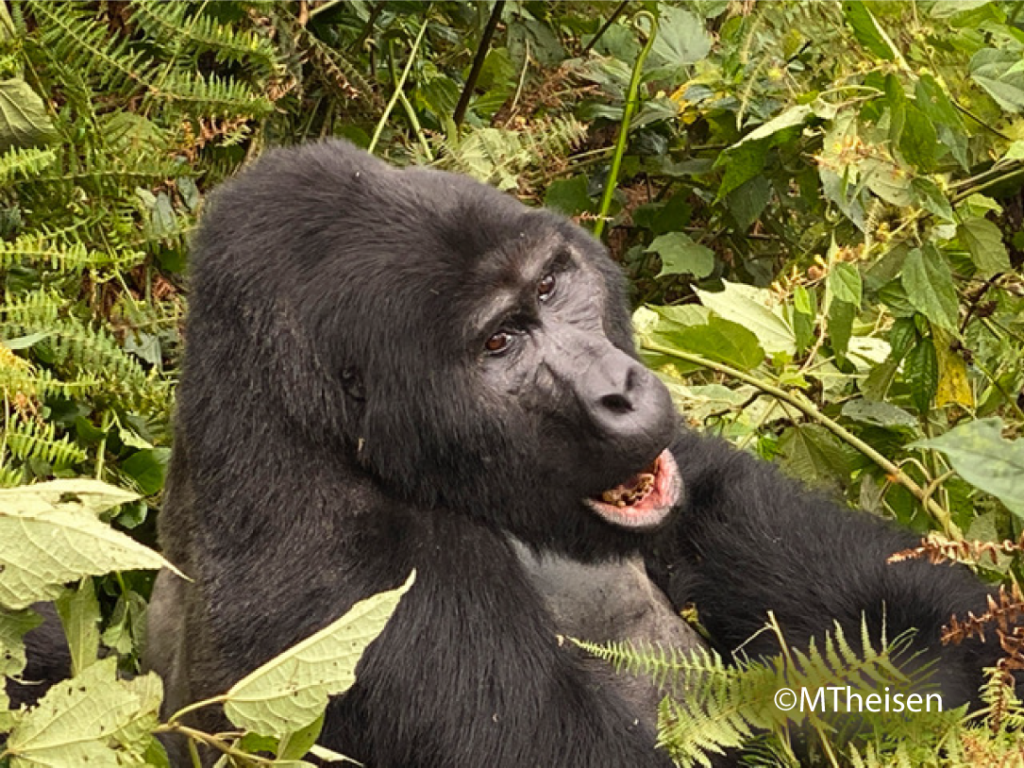
BONUS: Avail yourself of the other amazing parks in the region that feature other animals, including chimpanzees.
NOTE: Usually all photos are my own, but because of difficulties with cameras and stomachs, I am gratefully including some by Abiaz Rwamwiri from those two days.

